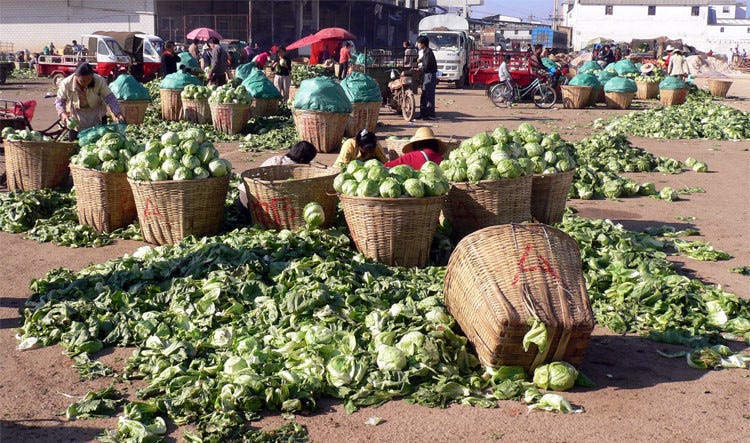
https://miro.medium.com/max/1400/0*Ap2Ra1DJqYglZ6wL
Nature of Post Harvest Losses:
Losses occur after harvesting is known as post harvest losses. It starts first from the field, after harvest, in grading and packing areas, in storage, during transportation and in the wholesale and retail markets. Several losses occur because of poor facilities, lack of know-how, poor management, market dysfunction or simply the carelessness of farmers.
1. Extend of Post Harvest Loss:
It is evident that the estimation of post-harvest loss is essential to make available more food from the existing level of production. A recent joint study conducted by the management consultancy firm, McKinsey and Co. and (The Confederation of Indian Industry (CII), at least 50% of the production of fruits and vegetab1es in the country is lost due to wastage and value destruction. The wastage cost is estimated to be Rs.23, 000 crores each year. Swaminathan Committee (1980) reported the post-harvest handling accounts for 20-30% of the losses at different stages of storage, grading, packing, transport and finally marketing as a fresh produce or in the processed form. According to Chadha (2009) India loses about 35-45% of the harvested fruits and vegetables during handling, storage, transportation etc. leading to the loss of Rs. 40,000 crores per year.
Important sites where post-harvest losses are
noticed in India are —
• Farmer’s field (15-20%)
• Packaging (15_2004)
•. Transportation (30-40%)
• Marketing (30-40%)
3. Estimated Losses of Fruits:
4. Estimated Loss of Vegetables:
Causes of Post Harvest Losses:
Horticultural crops not only provide nutritional and healthy foods to human beings, but also generate a considerable cash income for growers. However, horticultural crops typically have high moisture content, tender texture and high perishability. If not handled properly, a highvalue nutritious product can deteriorate and rot in a matter of days or hours. The causes of postharvest losses can be divided into different categories:
All fresh horticultural crops are live organs. The natural process of respiration involves the breakdown of food reserves and the aging of these organs.
Owing to their tender texture and high moisture content, fresh fruits and vegetables are very susceptible to mechanical injury. Poor handling, unsuitable containers, improper packaging and transportation can easily cause bruising, cutting, breaking, impact wounding and other forms of injury.
These include sprouting, rooting, seed germination, which lead to deterioration in quality and nutritional value.
High post-harvest losses are caused by the invasion of fungi, bacteria, insects and other organisms. Micro-organisms attack fresh produce easily and spread quickly, because the produce does not have much of a natural defense mechanism and has plenty of nutrients and moisture to support microbial growth.
Fruits and vegetable cells are still alive after harvest and continue their physiological activity. Physiological disorders may occur due to mineral deficiency, low or high temperature injury or undesirable atmospheric conditions, such as high humidity, physiological deterioration can also occur spontaneously by enzymatic action leading to over-ripeness and senescence, a simple aging phenomenon.
Poor planning pr inaccurate production and market information may lead to over production of certain fruits or vegetables which can’t be sold in time. This situation occurs most frequently in areas where transportation and storage facilities are inadequate. Produce may lie rotting in production areas, if farmers are unable to transport it to people who need it in distant locations.
These losses can be due to inadequate preservation methods at home, methods of cooking and preparation such as peeling, consumption styles etc.
— Lack of clear concept of packing house operations.
— Lack of awareness among the growers, contractors and even the policy makers.
— Lack of infrastructure.
— Late realization of its importance,
— Inadequate technical support.
— Wide gap in technologies available and in vogue.
— Inadequate post-harvest quality control.
— Unorganized marketing.
— Absence of pre-cooling and cold storage.
— Inadequate market facilities, market intelligence and market information service (MIS)
— Poor storage facilities.
 |
| https://foodtank.com/wp-content/uploads/2016/08/iStock_edited.jpg |
Impact of Post Harvest Losses:
Post harvest losses of horticultural crops affect both the nutritious status of the population and economy of the country.
- Nutrition:
Fruits and vegetables are rich source of vitamins and minerals essential for human nutrition. These are wasted in transit from harvest to consumer represent a loss in the quantity of a valuable food. This is important not only in quantitative terms, but also from the point of view of quality nutrition.
- Economy:
Careless harvesting and rough handling of perishable bruise and scar the skin, thus reducing quality and market price. Such damaged produce also fails to attract the international buyers, and bring the exporting country less profit and bad name. This ultimately results in huge economic losses to the country. For improving the situation, it is essential to create awareness among growers, farm workers, manager’s traders and exporters about the extent of losses being incurred and their economic consequences. These groups of people involved in the fruit industry also need to learn the basic principles of fruit handling and storage. In addition, the government needs to provide basic infra-structure like storage, handling, grading, packing, transport and marketing facilities and technical expertise. This could be carried out by the public and private sector.
1. Sudheer, K.P. and V.Indira. 2007. Post harvest technology of horticultural crops. New India Publishing Agency, Nw Delhi.
2. Verma, L.R. and V.K. Joshi. 2000. Post harvest technology of fruits and vegetables – Handling, Processing, Fermentation and Waste Management. Indus Publishing Company. New Delhi.
3. Chadha, K.L. 2009. Handbook of Horticulture. IARI Publications, New Delhi.
4. Thompson, A.K. 1996. Post harvest technology of fruits and vegetables. Blackwell Science Ltd. London.








